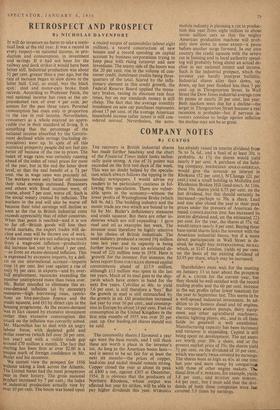RETROSPECT AND PROSPECT
By NICHOLAS DAVENPORT
Jr will do investors no harm to take a statis- tical look at the old year. It was a record in every respect—in national income, in pro- duction and consumption, in investment and savings. If it had not been for the railway and dock strikes it would have been better still. Industrial production was about 5f per cent. greater than a year ago, but the rate of increase began to slow down in the latter half. Coal, as usual, was the black spot : steel and motor-cars broke fresh records. According to Professor Paish, the real national income has risen at the un- precedented rate of over 4 per cent. per annum for the past three years. Personal consumption has risen only in proportion to the rise in real income. Nevertheless, consumers as a whole enjoyed an appre- ciable rise in their standard of living. It is something that the percentage of the national income absorbed by the Govern- ment declined while savings (including de- preciation) went up. In spite of all this statistical prosperity people did not feel any better off because of the rise in prices. The index of wage rates was certainly running ahead of the index of retail prices for most of the year, but in the end the latter drew level, so that the real benefit of a 73 per cent. rise in wage rates was precisely nil. The workers were only better off because their total earnings increased. Pensioners and others with fixed incomes were, of course, about 7 per cent. worse off. Such is the social misery created by inflation. The workers in the end will also be worse off because their total earnings will decline as soon as the 'rise in British industrial costs exceeds appreciably that of other countries. When that point is reached—and it is not so far off—British goods will lose their world markets, the export trades will de- cline and men will be thrown out of work. At the moment we are not suffering so much from a wage-cost inflation—productivity did increase last year by about 3 per cent. —as from an excess-demand inflation. This is expressed- by excessive imports, by a defi- cit on our international account—imports rose 16 per cent. last year against a rise of only 93 per cent. in exports—and by over- full employment, vacancies exceeding the number unemployed more than twice over. Mr. Butler intended to eliminate this ex- cess-demand inflation (a) by ,monetary measures—high borrowing rates, restric- tions on hire-purchase finance and the credit squeeze, and (b) by direct cuts in the housing programme. As the excess-demand was in fact caused by excessive investment rather than excessive consumption this attack on the inflation was correctly aimed. Mr. Macmillan has to deal with an angry labour force, with depleted gold and dollar reserves (which fell over 20 per cent. last year) and with a visible trade gap around £70 million a month. The fact that sterling has been firm at over $2.80 is a unique mark of foreign confidence in Mr. Butler and his successor.
We cannot view the prospect for 1956 Without taking a look across the Atlantic. The United States had the most prosperous Year in their history. The gross national Product increased by 7 per cent.; the index of , industrial production actually rose by over 10 per cent. The boom was based upon a record output of automobiles (about eight million), a record construction of new houses and a record spending on capital account by business corporations trying to keep pace with rising turnover and new inventions. The seamy side of the boom was the 20 per cent. rise in the volume of con- sumer credit, instalment credits being three- quarters of the total. Scared by the infla- tionary element in this credit growth, the Federal Reserve Board applied the mone- tary brakes, raising its discount rate four times, but on our standards money is still cheap. The fact that the average monthly instalment on new car purchases represents about 17 per cent. of the average American household income (after taxes) is still con- sidered normal. Nevertheless, the auto-
mobile industry is planning a cut in produc- tion this year from eight million to about seven million cars so that the mighty American production machine will prob- ably slow down to some extent—a pause before another surge forward. In our own country the credit squeeze with the severe cut in housing and in local authority spend- ing will probably bring about an actual de- cline in our national output and income. Such is the industrial prospect, which the investor can hardly interpret bullishly. Industrial shares after their down, up, down, up last year finished less than 5 per cent. up in Throgmorton Street. In Wall Street the Dow Jones industrial average rose 80 points or nearly 20 per cent. last year. Both markets seem due for a decline—the larger in Throgmorton Street because a real recession is probable—but if nervous in- vestors continue to hedge against inflation the decline may not be so great.


































 Previous page
Previous page